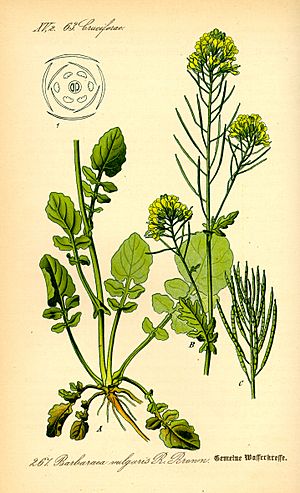Winter cress facts for kids
Quick facts for kids Winter cress |
|
|---|---|
 |
|
| Barbarea vulgaris | |
| Scientific classification |
|
| Kingdom: | Plantae |
| Clade: | Tracheophytes |
| Clade: | Angiosperms |
| Clade: | Eudicots |
| Clade: | Rosids |
| Order: | Brassicales |
| Family: | Brassicaceae |
| Genus: | Barbarea W. T. Aiton |
Barbarea is a group of plants often called winter cress or yellow rocket. These plants are part of the Brassicaceae family, which also includes vegetables like cabbage and broccoli. There are about 22 different kinds of Barbarea plants.
You can find Barbarea growing naturally in cooler parts of the Northern Hemisphere, especially in southern Europe and southwest Asia. They are usually small plants that grow for either two years (biennial) or many years (perennial). They have dark green leaves that are deeply cut, almost like a dandelion's. Their flowers are bright yellow and have four petals.
Contents
What is Barbarea?
Barbarea plants are known for growing quickly. They form a cluster of leaves close to the ground, similar to how dandelions grow. These leaves are edible and taste a bit like cress.
Types of Winter Cress
There are many different species (types) of Barbarea. Some common ones include Barbarea verna and Barbarea vulgaris. Each type might have slightly different features or grow in different places.
How People Use Winter Cress
Many kinds of Barbarea are edible. People often use the leaves in salads because they have a fresh, slightly peppery taste.
For example, Barbarea verna is known by several names like upland cress, early winter cress, or American cress. It's also sometimes called scurvy grass because, historically, it was eaten to help prevent scurvy, a sickness caused by not getting enough vitamin C. You can add its leaves to salads for a zesty flavor or mix them with other greens when cooking.
Natural Chemicals in Winter Cress
Like many plants, winter cress contains different natural chemicals. These include compounds called glucosinolates, flavonoids, and saponins. These chemicals are part of what gives the plant its unique taste and properties.
See also
 In Spanish: Barbarea para niños
In Spanish: Barbarea para niños

